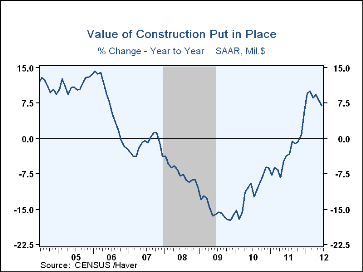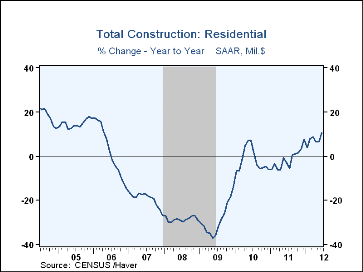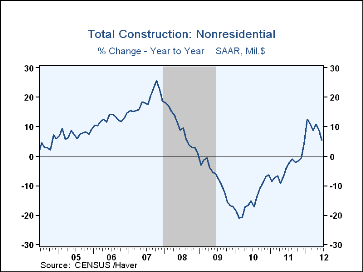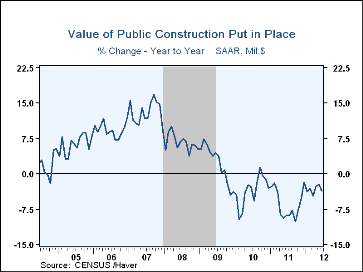 Global| Aug 01 2012
Global| Aug 01 2012U.S. Construction Spending Ticks Higher
by:Tom Moeller
|in:Economy in Brief
Summary
The value of construction put-in-place rose an expected 0.4% during June following a 1.6% May increase, initially reported as 0.9%. Private sector spending gained 0.7% (13.1% y/y) after a 2.1% May rise. Residential building continued [...]
The value of construction put-in-place rose an expected 0.4% during June following a 1.6% May increase, initially reported as 0.9%. Private sector spending gained 0.7% (13.1% y/y) after a 2.1% May rise. Residential building continued to recover strongly and increased 1.3% (12.1% y/y). Single-family construction increased 3.0% (18.6% y/y) and multi-family building rose 3.4% (48.8% y/y). The value of spending on improvements fell 0.8% (-3.4% y/y) following two months of strong increase.
In the public sector, building activity remained weak and was unchanged m/m (-3.7% y/y). Spending on highways & streets, which is 29% of total public construction spending, rose 1.5% (4.0% y/y) but office building declined 1.8% (-12.7% y/y). Educational building activity dropped 1.4% (-5.8% y/y) while transportation increased 3.7% (0.2% y/y).
The construction spending figures are in Haver's USECON database and the expectations figure is contained in the AS1REPNA database.
Just Released: Housing Checkup - Has the Market Finally Bottomed Out? from the Federal Reserve Bank of New York can be found here.
| Construction Put in Place (%) | Jun | May | Apr | Y/Y | 2011 | 2010 | 2009 |
|---|---|---|---|---|---|---|---|
| Total | 0.4 | 1.6 | 0.9 | 7.0 | -3.1 | -11.2 | -15.3 |
| Private | 0.7 | 2.1 | 1.4 | 13.1 | -1.1 | -15.2 | -22.4 |
| Residential | 1.3 | 3.1 | 1.9 | 12.1 | -1.0 | -2.9 | -29.9 |
| Nonresidential | 0.1 | 1.3 | 1.0 | 14.0 | -1.3 | -24.0 | -16.0 |
| Public | 0.0 | 0.5 | -0.1 | -3.7 | -6.4 | -3.6 | 2.1 |
Tom Moeller
AuthorMore in Author Profile »Prior to joining Haver Analytics in 2000, Mr. Moeller worked as the Economist at Chancellor Capital Management from 1985 to 1999. There, he developed comprehensive economic forecasts and interpreted economic data for equity and fixed income portfolio managers. Also at Chancellor, Mr. Moeller worked as an equity analyst and was responsible for researching and rating companies in the economically sensitive automobile and housing industries for investment in Chancellor’s equity portfolio. Prior to joining Chancellor, Mr. Moeller was an Economist at Citibank from 1979 to 1984. He also analyzed pricing behavior in the metals industry for the Council on Wage and Price Stability in Washington, D.C. In 1999, Mr. Moeller received the award for most accurate forecast from the Forecasters' Club of New York. From 1990 to 1992 he was President of the New York Association for Business Economists. Mr. Moeller earned an M.B.A. in Finance from Fordham University, where he graduated in 1987. He holds a Bachelor of Arts in Economics from George Washington University.










